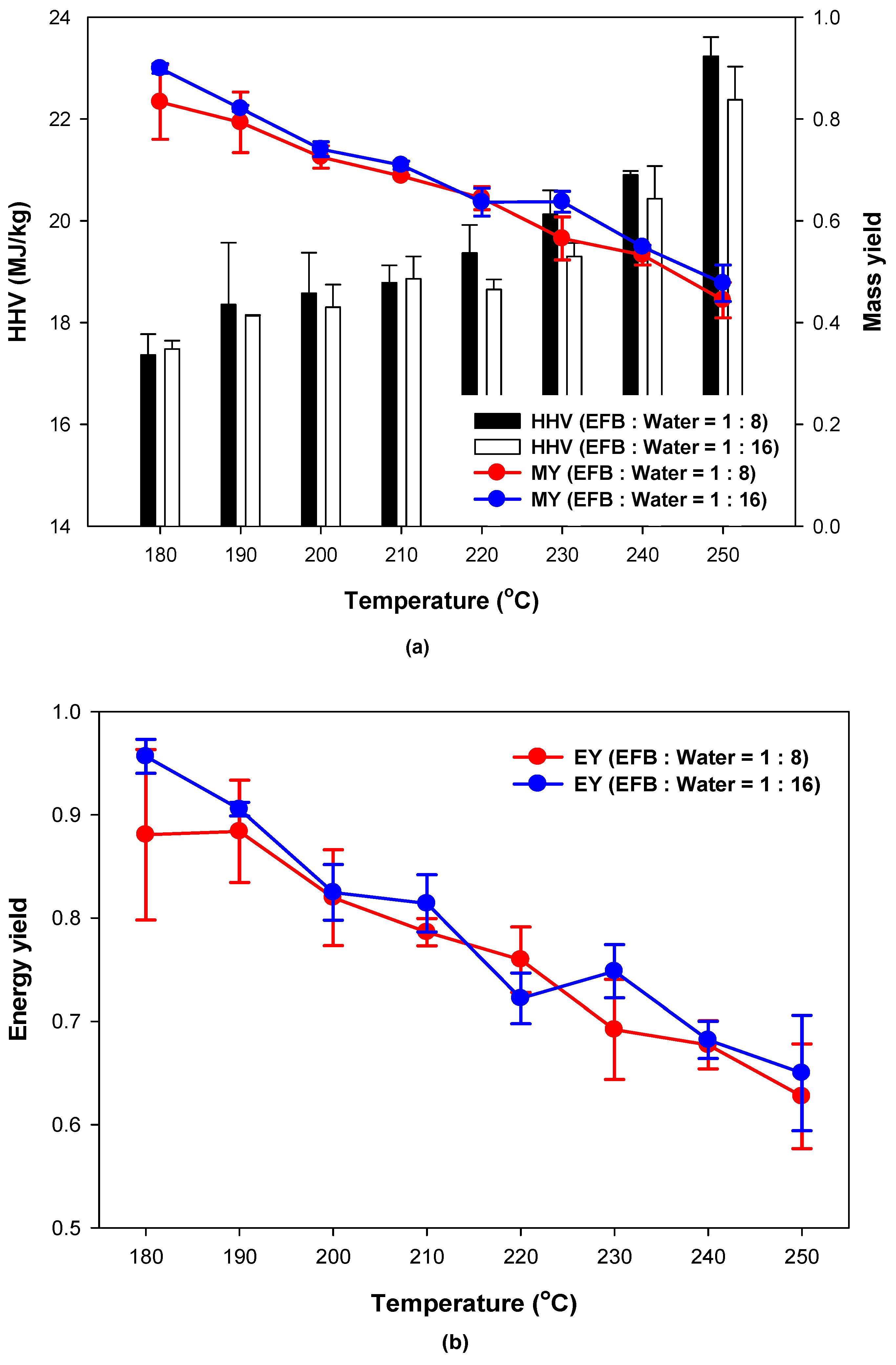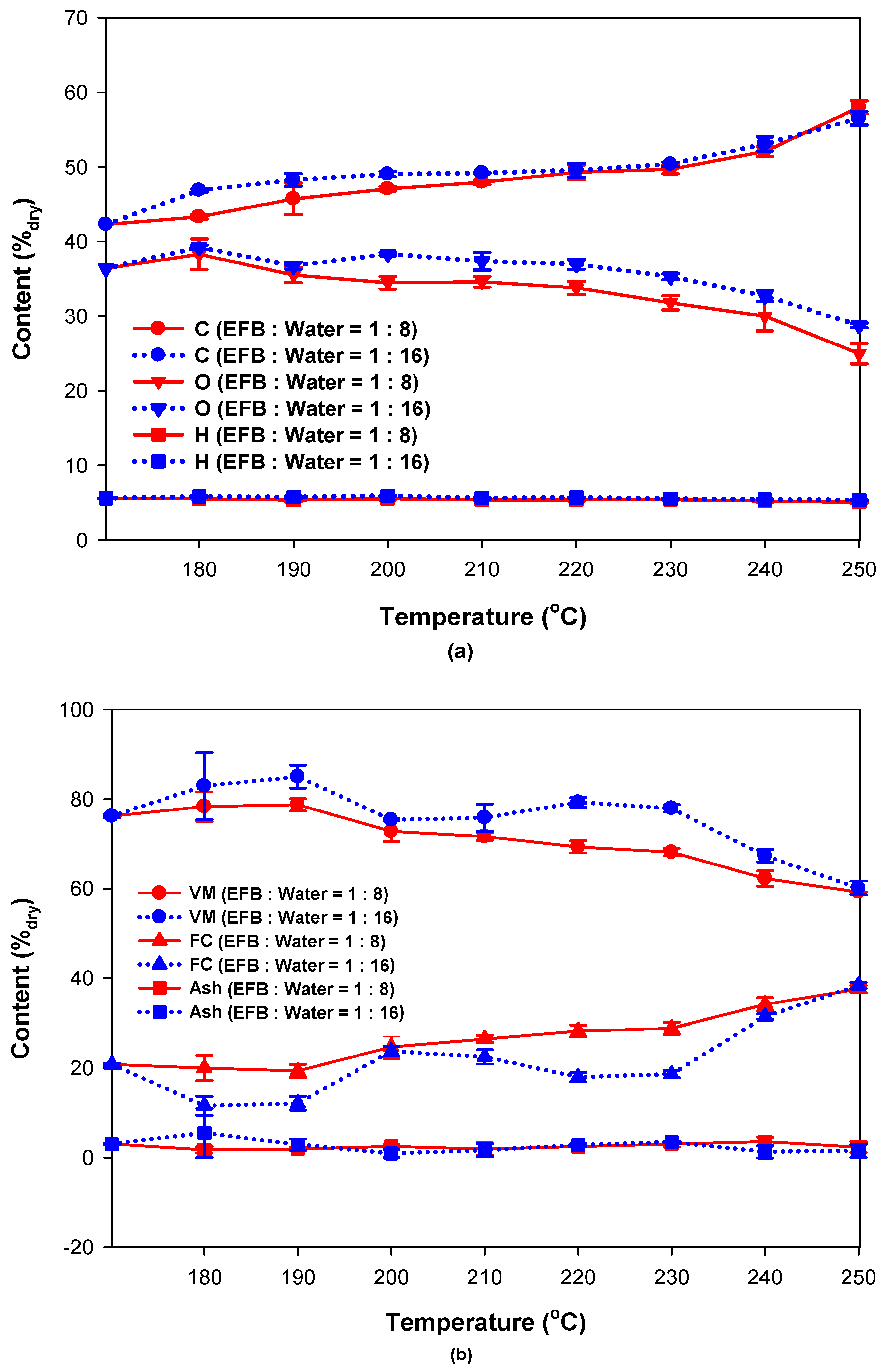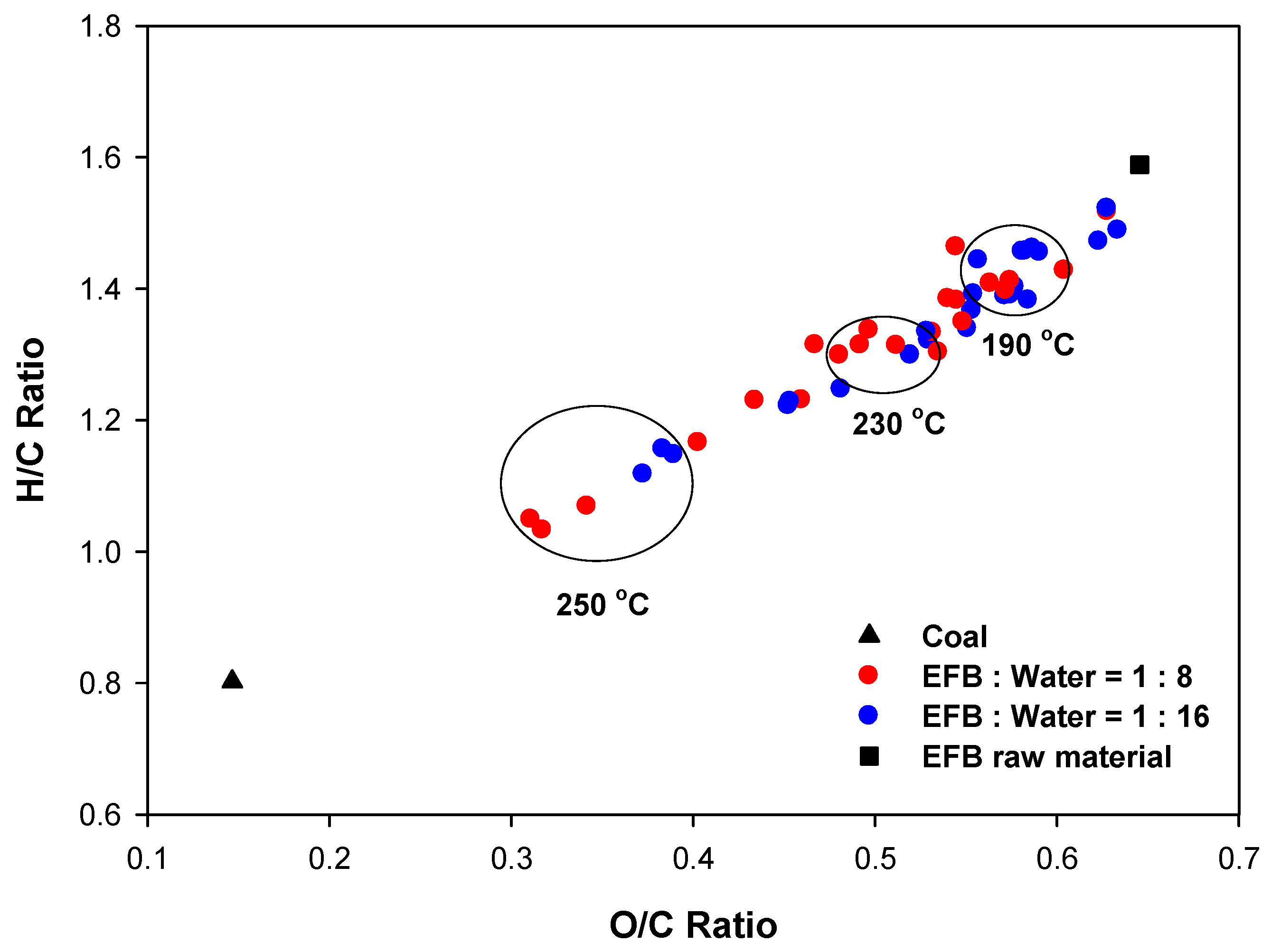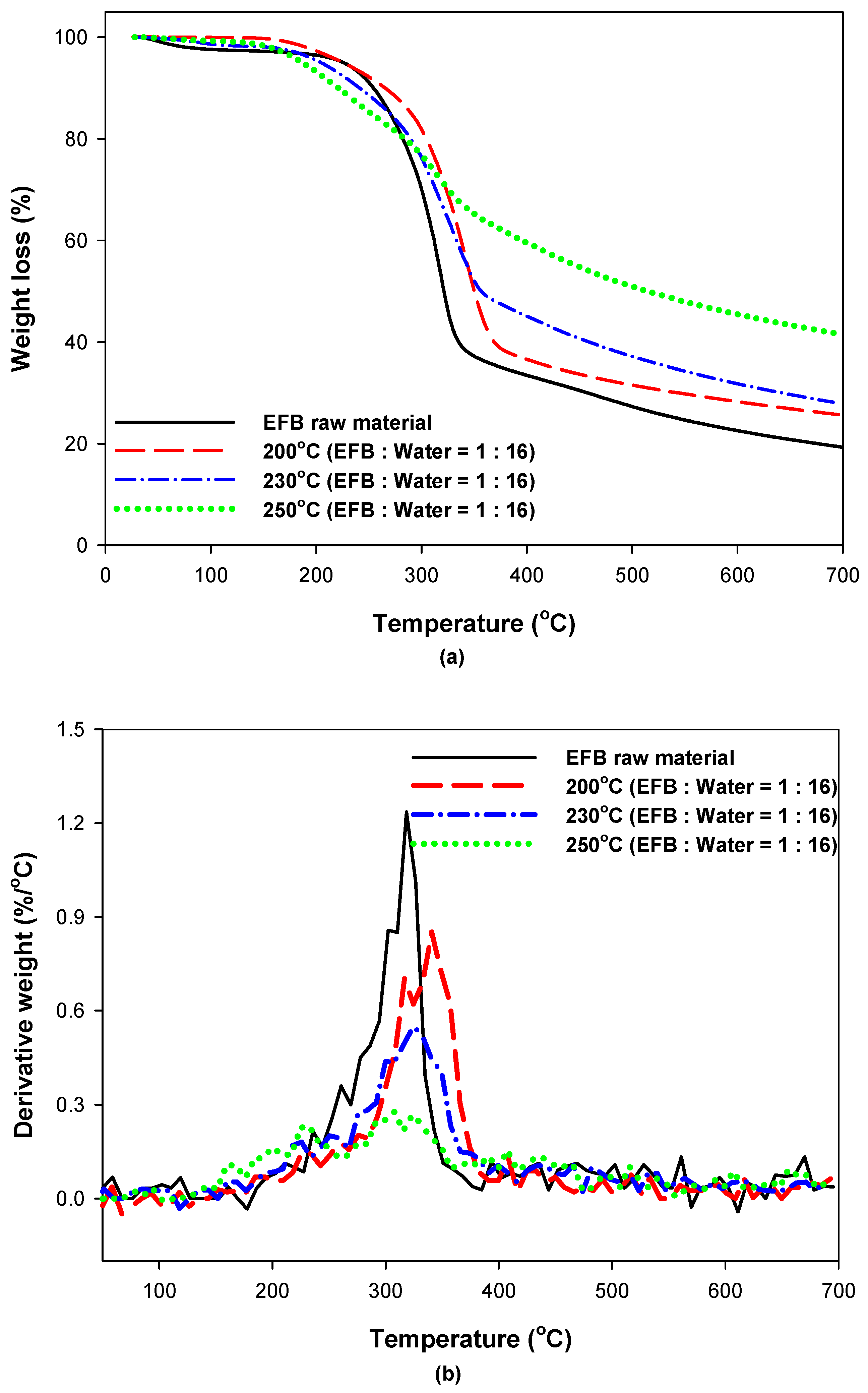Hydrothermal Treatment of Empty Fruit Bunches to Enhance Fuel Characteristics
Abstract
1. Introduction
2. Materials and Methods
2.1. Materials and Experimental Apparatus
2.2. Experimental Procedure and Analysis
3. Results and Discussion
3.1. Mass and Energy Yields
3.2. Elemental and Proximate Analysis
3.3. Fuel Characteristics of EFB after Hydrothermal Treatment
3.4. TGA and FT-IR Analysis
4. Conclusions
Author Contributions
Funding
Institutional Review Board Statement
Informed Consent Statement
Data Availability Statement
Acknowledgments
Conflicts of Interest
Abbreviation
| EFBs | Empty fruit bunches |
| TGA | Thermogravimetric analysis |
| DTG | Derivative thermogravimetry |
| FT-IR | Fourier transform infrared spectroscopy |
| HHV | Higher heating value |
| VM | Volatile matter |
| FC | Fixed carbon |
References
- Field, C.B.; Campbell, J.E.; Lobell, D.B. Biomass energy: The scale of the potential resource. Trends Ecol. Evol. 2008, 23, 65–72. [Google Scholar] [CrossRef] [PubMed]
- Fernandes, S.D.; Trautmann, N.M.; Streets, D.G.; Roden, C.A.; Bond, T.C. Global biofuel use, 1850–2000. Glob. Biogeochem. Cycles 2007, 21. [Google Scholar] [CrossRef]
- Richter, D., Jr.; Jenkins, D.H.; Karakash, J.T.; Knight, J.; McCreery, L.R.; Nemestothy, K.P. Wood energy in America. Science 2009, 323, 1432–1433. [Google Scholar] [CrossRef]
- Poudel, J.; Ohm, T.-I.; Gu, J.H.; Shin, M.C.; Oh, S.C. Comparative study of torrefaction of empty fruit bunches and palm kernel shell. J. Mater. Cycles Waste Manag. 2016, 19, 917–927. [Google Scholar] [CrossRef]
- Jamari, S.S.; Howse, J.R. The effect of the hydrothermal carbonization process on palm oil empty fruit bunch. Biomass Bioenergy 2012, 47, 82–90. [Google Scholar] [CrossRef]
- Khatun, R.; Reza, M.I.H.; Moniruzzaman, M.; Yaakob, Z. Sustainable oil palm industry: The possibilities. Renew. Sustain. Energy Rev. 2017, 76, 608–619. [Google Scholar] [CrossRef]
- Poudel, J.; Oh, S.C. Effect of Torrefaction on the Properties of Corn Stalk to Enhance Solid Fuel Qualities. Energies 2014, 7, 5586–5600. [Google Scholar] [CrossRef]
- Nhuchhen, D.; Basu, P.; Acharya, B. A Comprehensive Review on Biomass Torrefaction. Int. J. Renew. Energy Biofuels 2014, 2014, 1–56. [Google Scholar] [CrossRef]
- Funke, A.; Ziegler, F. Hydrothermal carbonization of biomass: A summary and discussion of chemical mechanisms for process engineering. Biofuels Bioprod. Biorefining 2010, 4, 160–177. [Google Scholar] [CrossRef]
- Novianti, S.; Nurdiawati, A.; Zaini, I.N.; Sumida, H.; Yoshikawa, K. Hydrothermal treatment of palm oil empty fruit bunches: An investigation of the solid fuel and liquid organic fertilizer applications. Biofuels 2016, 7, 627–636. [Google Scholar] [CrossRef]
- Yan, M.; Hantoko, D.; Susanto, H.; Ardy, A.; Waluyo, J.; Weng, Z.; Lin, J. Hydrothermal treatment of empty fruit bunch and its pyrolysis characteristics. Biomass Convers. Biorefinery 2019, 9, 709–717. [Google Scholar] [CrossRef]
- Nonaka, M.; Hirajima, T.; Sasaki, K. Upgrading of low rank coal and woody biomass mixture by hydrothermal treatment. Fuel 2011, 90, 2578–2584. [Google Scholar] [CrossRef]
- Zhao, P.; Shen, Y.; Ge, S.; Chen, Z.; Yoshikawa, K. Clean solid biofuel production from high moisture content waste biomass employing hydrothermal treatment. Appl. Energy 2014, 131, 345–367. [Google Scholar] [CrossRef]
- Toor, S.S.; Rosendahl, L.; Rudolf, A. Hydrothermal liquefaction of biomass: A review of subcritical water technologies. Energy 2011, 36, 2328–2342. [Google Scholar] [CrossRef]
- Yang, T.; Liu, X.; Li, R.; Li, B.; Kai, X. Hydrothermal liquefaction of sewage sludge to produce bio-oil: Effect of co-pretreatment with subcritical water and mixed surfactants. J. Supercrit. Fluids 2019, 144, 28–38. [Google Scholar] [CrossRef]
- Lynam, J.G.; Coronella, C.J.; Yan, W.; Reza, M.T.; Vasquez, V.R. Acetic acid and lithium chloride effects on hydrothermal carbonization of lignocellulosic biomass. Bioresour. Technol. 2011, 102, 6192–6199. [Google Scholar] [CrossRef] [PubMed]
- Hägglund, S.; Vatkolning av Torv, A.B. Svensk Torvförädling; Lund University: Lund, Sweden, 1960; p. 188. [Google Scholar]
- Wang, Y.; Qiu, L.; Zhu, M.; Sun, G.; Zhang, T.; Kang, K. Comparative Evaluation of Hydrothermal Carbonization and Low Temperature Pyrolysis of Eucommia ulmoides Oliver for the Production of Solid Biofuel. Sci. Rep. 2019, 9, 5535. [Google Scholar] [CrossRef] [PubMed]
- Siskin, M.; Katritzky, A.R. Reactivity of Organic Compounds in Hot Water: Geochemical and Technological Implications. Science 1991, 254, 231–237. [Google Scholar] [CrossRef]
- Engel, M.H.; Macko, S.A. Organic Geochemistry: Principles and Applications; Springer Science & Business Media: Berlin/Heidelberg, Germany, 2013; Volume 11. [Google Scholar]
- Bobleter, O. Hydrothermal degradation of polymers derived from plants. Prog. Polym. Sci. 1994, 19, 797–841. [Google Scholar] [CrossRef]
- Mok, W.S.H.; Antal, M.J., Jr.; Szabo, P.; Verhegyi, G.; Zelei, B. Formation of charcoal from biomass in a sealed reactor. Ind. Eng. Chem. Res. 1992, 31, 1162–1166. [Google Scholar] [CrossRef]
- Schwald, W.; Bobleter, O. Hydrothermolysis of Cellulose Under Static and Dynamic Conditions at High Temperatures. J. Carbohydr. Chem. 1989, 8, 565–578. [Google Scholar] [CrossRef]
- Siskin, M.; Katritzky, A.R. Reactivity of Organic Compounds in Superheated Water: General Background. Chem. Rev. 2001, 101, 825–836. [Google Scholar] [CrossRef] [PubMed]
- Léger, S.; Chornet, E.; Overend, R. Characterization and quantification of changes occurring in the low-severity dewatering of peat. Int. J. Coal Geol. 1987, 8, 135–146. [Google Scholar] [CrossRef]
- Parikh, J.; Channiwala, S.; Ghosal, G. A correlation for calculating elemental composition from proximate analysis of biomass materials. Fuel 2007, 86, 1710–1719. [Google Scholar] [CrossRef]
- Mohammad, I.N.; Ongkudon, C.M.; Misson, M. Physicochemical Properties and Lignin Degradation of Thermal-Pretreated Oil Palm Empty Fruit Bunch. Energies 2020, 13, 5966. [Google Scholar] [CrossRef]
- Kim, M.; Son, D.; Choi, J.-W.; Jae, J.; Suh, D.J.; Ha, J.-M.; Lee, K.-Y. Production of phenolic hydrocarbons using catalytic depolymerization of empty fruit bunch (EFB)-derived organosolv lignin on Hβ-supported Ru. Chem. Eng. J. 2017, 309, 187–196. [Google Scholar] [CrossRef]
- Uemura, Y.; Matsumoto, R.; Saadon, S.; Matsumura, Y. A study on torrefaction of Laminaria japonica. Fuel Process. Technol. 2015, 138, 133–138. [Google Scholar] [CrossRef]
- Yang, H.; Yan, R.; Chen, H.; Zheng, C.; Lee, A.D.H.; Liang, D.T. In-Depth Investigation of Biomass Pyrolysis Based on Three Major Components: Hemicellulose, Cellulose and Lignin. Energy Fuels 2006, 20, 388–393. [Google Scholar] [CrossRef]
- Gan, M.J.; Lim, W.S.; Ng, H.X.; Ong, M.H.; Gan, S.; Lee, L.Y.; Thangalazhy-Gopakumar, S. Enhancement of Palm Kernel Shell Fuel Properties via Wet Torrefaction: Response Surface, Optimization, and Combustion Studies. Energy Fuels 2019, 33, 11009–11020. [Google Scholar] [CrossRef]
- Stevanic, J.S.; Salmén, L. Characterizing wood polymers in the primary cell wall of Norway spruce (Picea abies (L.) Karst.) using dynamic FT-IR spectroscopy. Cellulose 2007, 15, 285–295. [Google Scholar] [CrossRef]
- Wang, P.; Zhang, J.; Shao, Q.; Wang, G. Physicochemical properties evolution of chars from palm kernel shell pyrolysis. J. Therm. Anal. Calorim. 2018, 133, 1271–1280. [Google Scholar] [CrossRef]
- Park, J.; Meng, J.; Lim, K.H.; Rojas, O.J.; Park, S. Transformation of lignocellulosic biomass during torrefaction. J. Anal. Appl. Pyrolysis 2013, 100, 199–206. [Google Scholar] [CrossRef]









| Sample | Elemental Analysis (wt.%, Dry) | Proximate Analysis (wt.%, Dry) | HHV [MJ/kg] | ||||||
|---|---|---|---|---|---|---|---|---|---|
| C | H | N | O | Others | VM | FC | Ash | ||
| EFB | 42.3 | 5.6 | 0.2 | 36.4 | 15.5 | 76.6 | 20.5 | 2.9 | 16.4 |
| Temperature | 180 °C | 190 °C | 200 °C | 210 °C | 220 °C | 230 °C | 240 °C | 250 °C |
|---|---|---|---|---|---|---|---|---|
| Elemental analysis (wt.%, dry) | ||||||||
| C | 43.3 ± 0.13 | 45.7 ± 2.20 | 47.1 ± 0.00 | 47.9 ± 0.07 | 49.3 ± 0.64 | 49.7 ± 0.30 | 52.1 ± 0.78 | 58.0 ± 0.10 |
| H | 5.5 ± 0.01 | 5.4 ± 0026 | 5.6 ± 0.04 | 5.4 ± 0.03 | 5.4 ± 0.09 | 5.4 ± 0.01 | 5.2 ± 0.01 | 5.1 ± 1.39 |
| O | 38.3 ± 2.15 | 35.5 ± 1.15 | 34.5 ± 0.88 | 34.6 ± 0.37 | 33.8 ± 0.60 | 31.8 ± 0.60 | 30.0 ± 0.32 | 25.0 ± 1.39 |
| N | 0.5 ± 0.02 | 0.5 ± 0.01 | 0.4 ± 0.18 | 0.5 ± 0.20 | 0.5 ± 0.08 | 0.4 ± 0.09 | 0.6 ± 0.11 | 0.7 ± 0.10 |
| Others | 12.4 ± 2.31 | 12.9 ± 3.63 | 12.5 ± 1.01 | 11.5 ± 0.47 | 11.1 ± 1.26 | 12.7 ± 0.37 | 12.1 ± 0.98 | 11.2 ± 1.48 |
| Proximate analysis (wt.%, dry) | ||||||||
| VM | 78.3 ± 2.70 | 78.7 ± 1.39 | 72.8 ± 2.33 | 71.6 ± 0.28 | 69.3 ± 1.51 | 68.1 ± 0.77 | 62.3 ± 0.25 | 59.2 ± 0.06 |
| FC | 20.0 ± 1.90 | 19.4 ± 1.62 | 24.7 ± 2.81 | 26.5 ± 0.93 | 28.3 ± 1.44 | 28.9 ± 1.50 | 34.2 ± 1.13 | 37.6 ± 0.91 |
| Ash | 1.7 ± 0.81 | 1.9 ± 0.24 | 2.5 ± 0.48 | 1.9 ± 1.21 | 2.5 ± 0.07 | 3.0 ± 0.74 | 3.6 ± 0.88 | 2.3 ± 0.07 |
| Temperature | 180 °C | 190 °C | 200 °C | 210 °C | 220 °C | 230 °C | 240 °C | 250 °C |
|---|---|---|---|---|---|---|---|---|
| Elemental analysis (wt.%, dry) | ||||||||
| C | 46.8 ± 0.21 | 48.2 ± 0.92 | 49.0 ± 0.39 | 49.2 ± 0.07 | 49.6 ± 0.58 | 50.4 ± 0.27 | 53.1 ± 0.13 | 56.5 ± 0.31 |
| H | 5.8 ± 0.08 | 5.8 ± 0.15 | 6.0 ± 0.04 | 5.6 ± 0.06 | 5.7 ± 0.03 | 5.5 ± 0.10 | 5.5 ± 0.03 | 5.4 ± 0.10 |
| O | 39.2 ± 0.20 | 36.8 ± 0.26 | 38.3 ± 0.04 | 37.4 ± 1.00 | 37.0 ± 0.78 | 35.3 ± 0.37 | 32.7 ± 0.70 | 28.8 ± 0.29 |
| N | 0.4 ± 0.06 | 0.5 ± 0.04 | 0.3 ± 0.01 | 0.5 ± 0.06 | 0.5 ± 0.02 | 0.5 ± 0.07 | 0.6 ± 0.04 | 0.8 ± 0.03 |
| Others | 7.7 ± 0.39 | 8.7 ± 0.77 | 6.3 ± 0.46 | 7.3 ± 1.06 | 7.3 ± 1.36 | 8.3 ± 0.66 | 8.2 ± 0.90 | 8.6 ± 0.73 |
| Proximate analysis (wt.%, dry) | ||||||||
| VM | 82.9 ± 8.55 | 85.0 ± 2.70 | 75.4 ± 0.19 | 75.8 ± 1.18 | 79.3 ± 1.18 | 77.9 ± 0.95 | 67.3 ± 1.33 | 60.1 ± 1.37 |
| FC | 11.6 ± 2.18 | 12.1 ± 1.30 | 23.7 ± 0.08 | 22.5 ± 0.53 | 18.0 ± 1.18 | 18.6 ± 0.93 | 31.4 ± 0.55 | 38.4 ± 0.23 |
| Ash | 5.5 ± 6.36 | 2.9 ± 1.43 | 0.9 ± 0.27 | 1.7 ± 0.66 | 2.8 ± 0.01 | 3.5 ± 0.02 | 1.3 ± 0.78 | 1.5 ± 1.60 |
Publisher’s Note: MDPI stays neutral with regard to jurisdictional claims in published maps and institutional affiliations. |
© 2021 by the authors. Licensee MDPI, Basel, Switzerland. This article is an open access article distributed under the terms and conditions of the Creative Commons Attribution (CC BY) license (http://creativecommons.org/licenses/by/4.0/).
Share and Cite
Kim, H.J.; Park, C.; Nepal, R.; Oh, S.C. Hydrothermal Treatment of Empty Fruit Bunches to Enhance Fuel Characteristics. Energies 2021, 14, 1467. https://doi.org/10.3390/en14051467
Kim HJ, Park C, Nepal R, Oh SC. Hydrothermal Treatment of Empty Fruit Bunches to Enhance Fuel Characteristics. Energies. 2021; 14(5):1467. https://doi.org/10.3390/en14051467
Chicago/Turabian StyleKim, Hyeok Jin, Chan Park, Rabin Nepal, and Sea Cheon Oh. 2021. "Hydrothermal Treatment of Empty Fruit Bunches to Enhance Fuel Characteristics" Energies 14, no. 5: 1467. https://doi.org/10.3390/en14051467
APA StyleKim, H. J., Park, C., Nepal, R., & Oh, S. C. (2021). Hydrothermal Treatment of Empty Fruit Bunches to Enhance Fuel Characteristics. Energies, 14(5), 1467. https://doi.org/10.3390/en14051467






